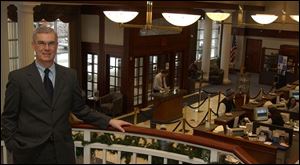
Defiance banker has ear of Fed
1/7/2004
At home here in the First Federal Bank in Defiance, Mr. Small is the new head of the Fed s Thrift advisory board.
It s well-known that when Federal Reserve Chairman Alan Greenspan talks, most everyone listens.
Not so well known is that when Defiance banker William J. Small talks, Mr. Greenspan listens.
That s because, as a member of the Thrift Institutions Advisory Council of the Federal Reserve Board, Mr. Small meets three times a year with Mr. Greenspan and his Board of Governors to discuss issues relating to savings and loans, savings banks, and credit unions.
This year, Mr. Small, chief executive of First Defiance Financial Corp., will be the council s president.
“This is one of the most interesting experiences I ve ever been involved with,” said Mr. Small, who has spent more than 25 years working at thrifts. Most of those years have been with First Defiance or its main banking unit, First Federal Bank of the Midwest, which has $1 billion in assets.
Mr. Small, 53, recently finished a two-year term on the 12-member council after being appointed by the Fed board of governors and was then approached about serving a one-year term as president.
It was an opportunity he welcomed because of the complexities now facing the thrift industry, which was rocked in the 1980s by a scandal that saw hundreds of institutions fail.
The Thrift Institutions Advisory Council, established in 1980 by the Fed governors, is one of three panels that directly advise the nation s board that oversees monetary policy. The others are the Consumer Advisory Council and the Federal Advisory Council.
Where savings and loans were once involved only in residential real-estate lending, Mr. Small said, a thrift charter today allows it to do almost anything a commercial bank does, including commercial lending.
“It s a lot different ballgame then it was 25 years ago, and there s a whole lot more paperwork.”
About 10 days before the meeting with the Fed board, he explained, the council members receive a list of topics the governors want to talk about. Then, about four or five days before the meeting, the members are sent “a bunch of reading material” and asked for their input on how the issues might impact the thrift industry.
“It could be anything from mortgage lending to capital issues at one session,” he said. “Then the other things are always a constant, like the economic conditions in each of our geographic regions.”
Once the council gathers - the first 2004 meeting is slated for March 4 and 5 - the members share opinions in an all-day session, discussing each of the topics individually and coming up with a consensus view.The next day, those views are presented to Mr. Greenspan and the board of governors.
Mr. Small guesses this year s topics will include proposed changes in the Real Estate Settlement Procedures Act, predatory lending, corporate governance, and the structure and regulation of such government-sponsored entities as Fannie Mae and Freddie Mac.
The council is made up of chief executives from all over the country and from all sizes of institutions, with some having as little as $150 million in assets and others up to $75 billion.
He is reluctant to point to specific changes that have grown out of the meetings but he said he knows the Fed chairman is listening.
“One of the really gratifying comments that Mr. Greenspan said is, One of the things I really appreciate from this council is I get to hear what s going on outside the metropolitan area, ” Mr. Small said.